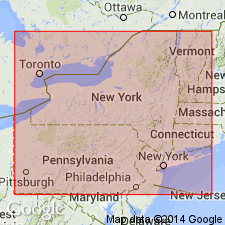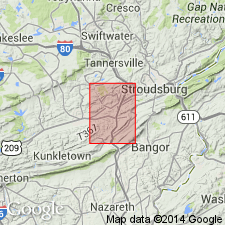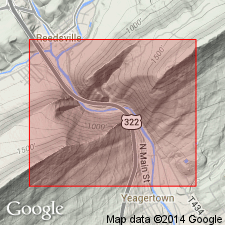
- Usage in publication:
-
- Shawangunk grit
- Modifications:
-
- Named
- Dominant lithology:
-
- Conglomerate
- Sandstone
- AAPG geologic province:
-
- Appalachian basin
Summary:
Named Shawangunk grit for Shawangunk Mountain, Ulster Co., NY. Unit varies from conglomerate to fine-grained grit rock and is almost entirely siliceous. Generally white or light gray, but there is one bed at the upper part of its mass that is red. In some places the upper strata are more or less loaded with pyrites. Thickness is 0-500 ft. It is overlain by the Helderberg limestone group and unconformably overlies the Hudson River slate group. Shawangunk is considered to be of Silurian age.
Source: GNU records (USGS DDS-6; Reston GNULEX).

- Usage in publication:
-
- Shawangunk Formation
- Modifications:
-
- Age modified
- AAPG geologic province:
-
- Appalachian basin
Summary:
Traced Silurian rocks in the subsurface from central NY to the outcrops at Delaware Water Gap and Lehigh Gap and determined that the Shawangunk Formation in eastern PA is Early and Middle Silurian in age.
Source: GNU records (USGS DDS-6; Reston GNULEX).

- Usage in publication:
-
- Shawangunk Formation*
- Modifications:
-
- Age modified
- AAPG geologic province:
-
- Appalachian basin
Summary:
Age of Shawangunk Formation changed from Late Ordovician(?) through Middle Silurian to Early and Middle Silurian. Age change based on work by Rickard (1984) who traced Silurian rocks in the subsurface to outcrop and determined age in eastern PA be Early and Middle Silurian.
Source: GNU records (USGS DDS-6; Reston GNULEX).

- Usage in publication:
-
- Shawangunk Formation*
- Modifications:
-
- Revised
- Age modified
- AAPG geologic province:
-
- Appalachian basin
Summary:
In southeastern NY, the Shawangunk is divided into two tongues that intertongue with the Bloomsburg Red Beds. The lower tongue is the Ellenville Tongue which consists of medium-dark-gray to light-gray, medium- to thick-bedded, planar-bedded and cross-bedded, fine- to medium grained quartzite, conglomerate, and minor red and green shaly siltstone. The Ellenville Tongue conformably overlies the Wurtsboro Tongue of the Bloomsburg and conformably underlies the Basher Kill Tongue of the Bloomsburg. The upper tongue of the Shawangunk is the High View Tongue which consists of gray, thin-bedded quartz sandstone with well-sorted and rounded quartz grains, and some green shale. The High View Tongue overlies the Basher Kill Tongue of the Bloomsburg and underlies the Poxono Island Formation. The intertonguing relationship of the Shawangunk and Bloomsburg requires that the Shawangunk be of Middle and Late Silurian age in southeastern NY.
Source: GNU records (USGS DDS-6; Reston GNULEX).

- Usage in publication:
-
- Shawangunk Formation
- Modifications:
-
- Biostratigraphic dating
- AAPG geologic province:
-
- Appalachian basin
Summary:
Lower part of the Shawangunk Formation with eurypterids is most likely of Llandoverian age. Upper part of Shawangunk containing VERNONASPIS-bearing beds is now assigned a Ludlovian age.
Source: GNU records (USGS DDS-6; Reston GNULEX).
For more information, please contact Nancy Stamm, Geologic Names Committee Secretary.
Asterisk (*) indicates published by U.S. Geological Survey authors.
"No current usage" (†) implies that a name has been abandoned or has fallen into disuse. Former usage and, if known, replacement name given in parentheses ( ).
Slash (/) indicates name conflicts with nomenclatural guidelines (CSN, 1933; ACSN, 1961, 1970; NACSN, 1983, 2005, 2021). May be explained within brackets ([ ]).

